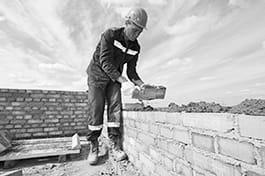Profession bricklayer

Construction bricklayers lay and bind bricks, pre-cut stone, concrete blocks and other types of building blocks in/with mortar and other substances to construct walls, foundations, partitions, arches and other structures.
Bricklayer Jobs: Open positions
Find the job of your dreams on Talent.com, one of the largest job sites worldwide.
Job postings: talent.comPersonality Type
Tasks bricklayer
- Analyze and interpret work orders, e.g. study drawings to determine specifications and to calculate the materials required.
- Measure distance from reference points and mark guidelines to lay out work, e.g. using plumb bobs and levels.
- Calculate angles and courses and determine vertical and horizontal alignment of courses.
- Lay courses of bricks and other building blocks, from corner to corner, using mason's line.
- Break or cut bricks and other building blocks to size, using tools such as trowel edges or hammers.
- Mix specified amounts of sand, clay, cement or mortar powder with water.
- Apply and smooth mortar or other mixture over work surface to serve as a base and binder for bricks.
- Fasten bricks or other building blocks to structure, for example with wire clamps, anchor holes or cement.
- Perform isolation works.
- Remove excess mortar, e.g. with trowels and hand tools, and finish mortar joints with jointing tools for a sealed uniform appearance.
- Erect scaffolding.
Related professions building, construction
- Architect
- Blocklayer
- Building repairer
- Building wrecker
- Construction block mason
- Construction company manager
- Construction contractor
- Construction designer
- Construction operative
- Construction or building inspector
- Construction work planner
- Fence erector
- First line supervisor construction workers
- Glass decorating sandblaster
- House builder
- Insulation worker
- Iron worker
- Jointer
- Kit worker
- Prefabricated buildings erector
- Project manager civil engineering
- Project manager construction
- Quantity surveyor
- Town planner
Skills
- Sort waste
Manually or automatically sort waste by separating it into its different elements.
- Lay bricks
Lay bricks in the specified pattern and apply a layer of mortar to create walls. Make sure every course of bricks is level and flush.
- Transport construction supplies
Bring construction materials, tools and equipment to the construction site and store them properly taking various aspects into account such as the workers' safety and protection from deterioration.
- Use measurement instruments
Use different measurement instruments depending on the property to be measured. Utilise various instruments to measure length, area, volume, speed, energy, force, and others.
- Split bricks
Use the appropriate tools to trim, split and shape bricks for use in walls. Use a mason's hammer for occasional shaping, and a hammer and chisel for larger quantities or when the split has to be especially straight.
- Inspect construction supplies
Check construction supplies for damage, moisture, loss or other problems before using the material.
- Work ergonomically
Apply ergonomy principles in the organisation of the workplace while manually handling equipment and materials.
- Interpret 3D plans
Interpret and understand plans and drawings in manufacturing processes which include representations in three dimensions.
- Follow health and safety procedures in construction
Apply the relevant health and safety procedures in construction in order to prevent accidents, pollution and other risks.
- Interpret 2D plans
Interpret and understand plans and drawings in manufacturing processes which include representations in two dimensions.
- Install construction profiles
Install a variety of metal or plastic profiles used to attach materials to each other or to structural elements. Cut them to size if called for.
- Finish mortar joints
Use a trowel to apply extra mortar to joints to smoothen and finish them after the mortar has partially hardened. Make sure that the joints are full to prevent dampness and other outside influences from passing through the wall.
- Mix construction grouts
Mix construction materials with water and other materials based on the appropriate recipe. Mix thoroughly to prevent lumps. Avoid contamination, which will adversely affect the properties of the mixture.
- Check straightness of brick
Use tools such as the level or the mason's line to check if the wall is straight and flush, and take action if it isn't.
- Secure working area
Secure the operation site fixing boundaries, restricting access, placing signs and taking other measures in order to guarantee public and staff safety.
- Follow safety procedures when working at heights
Take necessary precautions and follow a set of measures that assess, prevent and tackle risks when working at a high distance from the ground. Prevent endangering people working under these structures and avoid falls from ladders, mobile scaffolding, fixed working bridges, single person lifts etc. since they may cause fatalities or major injuries.
- Use safety equipment in construction
Use elements of protective clothing such as steel-tipped shoes, and gear such as protective goggles, in order to minimise risk of accidents in construction and to mitigate any injury if an accident does occur.
- Snap chalk line
Stretch a line covered in fine, non-staining chalk between two points and snap it against a surface to produce a straight line.
Optional knowledge and skills
apply finish to concrete pour concrete document survey operations install insulation material install falsework estimate restoration costs apply proofing membranes set up temporary construction site infrastructure mix concrete use squaring pole calculate needs for construction supplies screed concrete work in a construction team keep personal administration keep records of work progress process incoming construction supplies rig loads place concrete forms monitor stock level operate surveying instruments maintain equipment inspect supplied concrete maintain work area cleanliness build scaffolding remove concrete forms apply restoration techniques reinforce concrete building codes order construction supplies operate masonry power sawSource: Sisyphus ODB